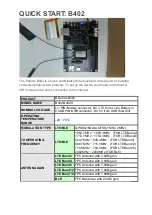
User Manual
624
Rev. 1.1
2019-03-18
TLE984xQX
Microcontroller with LIN and Power Switches for Automotive Applications
UART1/UART2
output position, it has a 1 and a sequence of zeros to its left. The control block then executes one last shift
before setting the TI bit.
Reception is started by the condition REN = 1 and RI = 0. At the start of the reception cycle, 11111110
B
is written
to the receive shift register. In each machine cycle that follows, the contents of the shift register are shifted left
one position and the value sampled on the RXD line in the same machine cycle is shifted in from the right.
When the 0 of the initial byte reaches the leftmost position, the control block executes one last shift, loads
SBUF and sets the RI bit.
The baud rate for the transfer is fixed at
f
sys
/2 where
f
sys
is the input clock frequency, i.e. one bit per machine
cycle.
19.3.2
Mode 1, 8-Bit UART, Variable Baud Rate
In mode 1, the UART behaves as an 8-bit serial port. A start bit (0), 8 data bits, and a stop bit (1) are transmitted
on TXD or received on RXD at a variable baud rate.
The transmission cycle is activated by a write to SBUF. The data are transferred to the transmit shift register
and a 1 is loaded to the 9th bit position (as in mode 0). At phase 1 of the machine cycle after the next rollover
in the divide-by-16 counter, the start bit is copied to TXD, and data is activated one bit time later. One bit time
after the data is activated, the data starts getting shifted right with zeros shifted in from the left. When the MSB
gets to the output position, the control block executes one last shift and sets the TI bit.
Reception is started by a high to low transition on RXD (sampled at 16 times the baud rate). The divide-by-16
counter is then reset and 1111 1111
B
is written to the receive register. If a valid start bit (0) is then detected
(based on two out of three samples), it is shifted into the register followed by 8 data bits. If the transition is not
followed by a valid start bit, the controller goes back to looking for a high to low transition on RXD. When the
start bit reaches the leftmost position, the control block executes one last shift, then loads SBUF with the 8
data bits, loads RB8 (SCON.2) with the stop bit, and sets the RI bit, provided RI = 0 (SCON.0), and either SM2 = 0
(SCON.5) (see
) or the received stop bit = 1. If none of these conditions is met, the received byte is
lost.
The associated timings for transmit/receive in mode 1 are illustrated in
.
















































